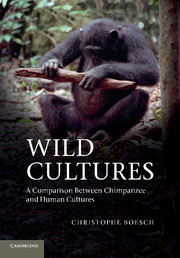Book contents
- Frontmatter
- Contents
- Acknowledgments
- Introduction
- 1 Studying culture in the wild
- 2 From human culture to wild culture
- 3 Shaping nature into home
- 4 One for all and all for one
- 5 I want to have sex with you
- 6 Learning culture
- 7 Dead or alive? Towards a notion of death and empathy
- 8 Wild culture – wild intelligence
- 9 Uniquely chimpanzee – uniquely human
- Epilogue: Will we have the time to study chimpanzee culture?
- References
- Index
2 - From human culture to wild culture
Published online by Cambridge University Press: 05 October 2012
- Frontmatter
- Contents
- Acknowledgments
- Introduction
- 1 Studying culture in the wild
- 2 From human culture to wild culture
- 3 Shaping nature into home
- 4 One for all and all for one
- 5 I want to have sex with you
- 6 Learning culture
- 7 Dead or alive? Towards a notion of death and empathy
- 8 Wild culture – wild intelligence
- 9 Uniquely chimpanzee – uniquely human
- Epilogue: Will we have the time to study chimpanzee culture?
- References
- Index
Summary
It is the Man of the past that by force is predominant in us, as the present is only little compared to our long past during which we shaped ourselves and from which we resulted.
Emile Durkheim, L’évolution pédagogique en France, 1938.The Grotte de Chauvet contains the oldest painting in the world, so man not only produces tools but also makes artistic objects.
Ryszard Kapuscinski, 2003.Eight-year-old Sartre was sitting on a root, facing his mother, Salomé, and watching her precisely positioning Panda nuts so that she could hit them exactly along the crack and open the shell without damaging the nuts inside. I could not stop thinking about the numerous drawings I had seen of our naked, hairy ancestors using stones to open nuts or crack long bones to reach the marrow. Sartre and his consorts produced numerous stone flakes while using granite hammers to crack some of the hardest nuts in Africa. I excavated such a chimpanzee site with the help of an archaeologist and, similar to what you would find in sites where humans made and used tools, we found hundreds of stone flakes, most of which were unintentional by-products of the nut-cracking activities. As a Panda nut requires a compression force of 1600 kg before it will break, it is no wonder little Sartre needed all his strength; to succeed, he had to stand and lift his 6-kg stone above his head with both hands and use all the force he could muster to both forcefully and precisely hit the nut. In contrast, Salomé, a strong adult, made this exercise look much easier with her more adept use of the same hammer. Sartre put his left hand out in a begging gesture and Salomé handed him half of her nut. Sartre broke a thin branch from a nearby sapling, cut a 12 cm long piece with his teeth, and chewed on one end to sharpen it. He then used the stick like a fork to extract the almond pieces embedded within the broken nutshell. Like the first time I had seen this done by an adult female, Sartre made a tool in front of my eyes and it took him less than one minute to select a twig, make three modifications to it, and start to use it.
- Type
- Chapter
- Information
- Wild CulturesA Comparison between Chimpanzee and Human Cultures, pp. 22 - 46Publisher: Cambridge University PressPrint publication year: 2012



